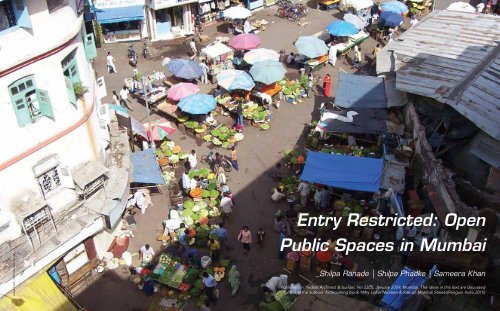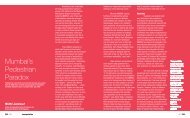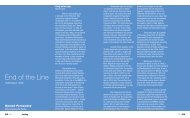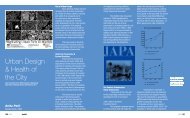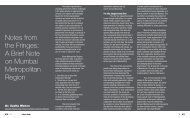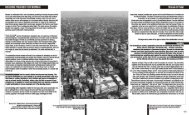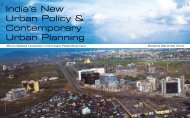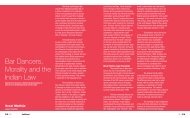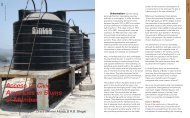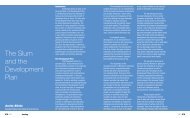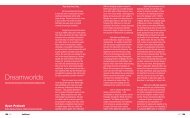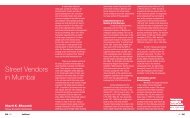Entry Restricted, Open Public Spaces in Mumbai.pdf - Urban Design ...
Entry Restricted, Open Public Spaces in Mumbai.pdf - Urban Design ...
Entry Restricted, Open Public Spaces in Mumbai.pdf - Urban Design ...
- No tags were found...
You also want an ePaper? Increase the reach of your titles
YUMPU automatically turns print PDFs into web optimized ePapers that Google loves.
OPEN SPACE | 436All work and hardly any play seemsto be the fate of the <strong>Mumbai</strong> women. As ourresearch on gender and public space <strong>in</strong> <strong>Mumbai</strong>revealed, there is an appall<strong>in</strong>g lack of publicrecreational space for women <strong>in</strong> the city.Parks and promenades lie at the heart of thecity’s open public spaces and the city’s attitudeto them reflects its attitude to its citizens. Theratio of open space per thousand residents <strong>in</strong>globally-aspirational <strong>Mumbai</strong> is a shameful 0.03acres as aga<strong>in</strong>st more than three acres <strong>in</strong> NewDelhi and Kolkata. The National Commission on<strong>Urban</strong>isation (1988) suggests that the ideal ratioof open spaces is 4 acres per 1,000 persons.Where parks do exist <strong>in</strong> <strong>Mumbai</strong>, they are notequally welcom<strong>in</strong>g to all and are often governedby an impulse not to <strong>in</strong>clude but to exclude.Given this grossly <strong>in</strong>adequate and rapidlyshr<strong>in</strong>k<strong>in</strong>g open space, one might naturally arguethat it is unfair for women to ask for space whenthere is hardly any public recreational spaceeven for others. We contend however, thatwomen’s access to open public space is closelyconnected to access for other groups of citizensto these spaces and cannot be seen <strong>in</strong> isolation.Our research on parks, maidans and seafrontsshows that many people felt uncomfortable<strong>in</strong> access<strong>in</strong>g these spaces. These spacesoften tend to be badly ma<strong>in</strong>ta<strong>in</strong>ed or policedstr<strong>in</strong>gently, both discourag<strong>in</strong>g popular use.<strong>Open</strong> public spaces are frequently seen asbe<strong>in</strong>g an <strong>in</strong>vitation for ‘anti-social-elements’who will somehow misuse them. In the pastdecade, the pressures of liberalisation and theconcomitant rise of right-w<strong>in</strong>g regionalist andcommunal politics has ensured that the list ofthose-who-do-not-really belong- to-the-city islarger than ever before. This now <strong>in</strong>cludes thepoor, the barely acknowledged lower castes,the typecast Muslims, the ‘immoral’ couples, the‘too different’ gays and lesbians, the ‘outsider’bhaiyas, the ‘encroacher’ hawkers, the ignoredelderly, and the <strong>in</strong>visible differently-abled.This social segregation and exclusion isreflected <strong>in</strong> the everyday spatial practices <strong>in</strong>the city. Cases <strong>in</strong> po<strong>in</strong>t are the new concepts ofpublic space management <strong>in</strong> the city such as paidparks and participation of local resident’s groups<strong>in</strong> the upkeep of public spaces. These have onone hand aesthetically improved the spacesunder their jurisdiction but on the other hand,they have reduced the access to many groups.In City Park at the Bandra-Kurla Complexfor example, the entry fee of Rs 5 is notmuch for middle-class people from nearbyneighbourhoods who use it regularly. But sett<strong>in</strong>ga fee for access<strong>in</strong>g a public space fundamentallymilitates aga<strong>in</strong>st the pr<strong>in</strong>ciple of public-ness andalso has the effect of segregat<strong>in</strong>g the space onthe basis of class. Those who cannot afford topay the entry fee everyday - if they happen tobe men, hang around outside the park; if theyare women they wait for weekends and publicholidays. Those are the special days whenfamilies from nearby slums <strong>in</strong> Dharavi, BharatNagar and Behrampada come there. Ironically,our <strong>in</strong>terviews show that on these days thepresence of work<strong>in</strong>g-class people, and <strong>in</strong> thiscase Muslims, marks the space as undesirablefor the local residents, especially women.Thus, while these parks privilege accessfor a certa<strong>in</strong> class of women (at certa<strong>in</strong> times),this is done at the cost of keep<strong>in</strong>g away othergroups of men who are seen as threats totheir safety and comfort, as well as womenfrom other classes and communities. Sucha method however, can only guaranteeconditional access for middle-class women.The creation of the image of some k<strong>in</strong>ds ofmen as the executors of violence aga<strong>in</strong>stwomen, provides the <strong>in</strong>disputable rationality forrestrict<strong>in</strong>g all women’s access to public space.Ironically, both the perceived aggressorand the potential victim become outsidersto public space based on this premise; poormen as potential perpetrators and women aspotential victims. The exclusion and vilificationof other marg<strong>in</strong>al citizens from public space is<strong>in</strong>extricably l<strong>in</strong>ked to the exclusion of women.Moreover, even <strong>in</strong> pure materialist terms,physical barriers designed to keep outcerta<strong>in</strong> people, effectively keep out womenas well. <strong>Urban</strong> designers and planners haverepeatedly po<strong>in</strong>ted out that the way to makea public space safer is not by keep<strong>in</strong>g out the‘undesirables’ but by encourag<strong>in</strong>g more andmore ‘desirables’. Ironically parks <strong>in</strong> <strong>Mumbai</strong>are proactively designed to discourage certa<strong>in</strong>groups from access<strong>in</strong>g them and this has theeffect of mak<strong>in</strong>g them unsafe for women as well.An example of this is the Oval Maidan,located along one of the busiest pedestriancorridors <strong>in</strong> South <strong>Mumbai</strong>, and restored <strong>in</strong>the late 1990s though <strong>in</strong>itiatives of a localcitizens group. The project was successful <strong>in</strong>aestheticis<strong>in</strong>g the space; yet fails to engagewith the city <strong>in</strong> any manner that would befitits scale and location. The maidan is policedmore str<strong>in</strong>gently and closed at night with the<strong>in</strong>tention of keep<strong>in</strong>g out ‘anti-social’ elements.The high iron fence restricts movement acrossthe maidan and creates deep uncomfortablecorners at the longer ends. In our <strong>in</strong>terviews,many women users of the park reported thatthey did not always feel comfortable us<strong>in</strong>g thespace. The light<strong>in</strong>g <strong>in</strong> the Oval is also foundwant<strong>in</strong>g. In sett<strong>in</strong>g up a variety of physicalbarricades aga<strong>in</strong>st undesirables, women arealso discouraged from us<strong>in</strong>g public spaces.In contrast, Shivaji Park – the only largemaidan <strong>in</strong> Central <strong>Mumbai</strong> - is a very goodexample <strong>in</strong> <strong>in</strong>clusiveness. The maidansupports activities rang<strong>in</strong>g from politicalrallies attended by tens of thousands tothe <strong>in</strong>timate conversations of couples. TheOPEN SPACE | 437
OPEN SPACE | 438shift<strong>in</strong>g activities <strong>in</strong> and around the maidanbeg<strong>in</strong> before day break and carry on late <strong>in</strong>tothe night. The low wide edge wall merelyacts to demarcate the maidan from thespace around it without restrict<strong>in</strong>g access.Although located <strong>in</strong> the middle of apredom<strong>in</strong>antly Maharashtrian residentiallocality, its openness gives it the sense ofbelong<strong>in</strong>g to the larger city. Moreover, thefact that the maidan is open at all times ofthe day and night, means that it is active untilquite late <strong>in</strong> the night. This is another factorthat makes women feel safe <strong>in</strong> and around it.Parks as open public spaces are also usedto impose a specific ‘moral vision’ of order onthe city. Citizens groups would like parks tocomply with a notion of middle - class aestheticsand morality - tim<strong>in</strong>gs for open<strong>in</strong>g and clos<strong>in</strong>g,rules about edibles, lists of dos and don’ts <strong>in</strong>the park, and the presence of visible securitysignifies not just beauty but also morality.In <strong>Mumbai</strong>, as <strong>in</strong> many cities across thecountry, this morality is peculiarly directedat public displays of romantic affection bycouples. S<strong>in</strong>ce the home is usually a space ofcrowd<strong>in</strong>g, couples often seek privacy alongpromenades or <strong>in</strong> parks across the city. Atvarious times police personnel have beendirected to discourage such couples byshoo<strong>in</strong>g them away or even arrest<strong>in</strong>g themon grounds of obscenity and/or immorality.In fact, this moral polic<strong>in</strong>g is also impr<strong>in</strong>tedon the body of the city through the designof public spaces such as park benches withdivid<strong>in</strong>g armrests and s<strong>in</strong>gleton seats. Someyears ago, <strong>in</strong> the Five Gardens at Dadarfor example, park benches were made<strong>in</strong>to s<strong>in</strong>gle-seaters to discourage couplesfrom engag<strong>in</strong>g <strong>in</strong> ‘<strong>in</strong>decent behavior’.Women are often the prime targets <strong>in</strong> suchcases of culture polic<strong>in</strong>g. When canoodl<strong>in</strong>gcouples are rounded up, it is often the youngwomen who are sought to be shamed bythreaten<strong>in</strong>g to <strong>in</strong>form their parents. Forexample <strong>in</strong> case of the Mar<strong>in</strong>e Drive rape <strong>in</strong>2005, a private security guard appo<strong>in</strong>ted by thelocal residents’ association, compla<strong>in</strong>ed to apoliceman about the victim and her male friendwho were hang<strong>in</strong>g out on Mar<strong>in</strong>e Drive, an openpublic promenade, <strong>in</strong> the late afternoon. Thepoliceman on duty then took the couple forquestion<strong>in</strong>g to the local police chowki, threwthe boy out, and then proceeded to rape her.Her ‘crime’ apparently was <strong>in</strong> be<strong>in</strong>g out witha boy <strong>in</strong> a public place on a hot afternoon.Certa<strong>in</strong>ly, the Mar<strong>in</strong>e Drive rape caseexample is an extreme. But no less is it truethat on an everyday basis women <strong>in</strong> publicare policed on where they are hang<strong>in</strong>g out,what they are wear<strong>in</strong>g, who they are with orwithout, what time they are out and so on.Although there are many women <strong>in</strong> publicspaces <strong>in</strong> <strong>Mumbai</strong>, our research shows thattheir access there is circumscribed by the needto demonstrate purpose and respectability.When be<strong>in</strong>g <strong>in</strong> a public park or promenadeposes a potential threat not just to theirphysical safety but also to their respectability,women are prone to avoid<strong>in</strong>g them.<strong>Open</strong> public spaces reflect the city’s attitudeto its citizens. The presence of sensitivelydesigned and welcom<strong>in</strong>g public spaces are ameasure of its <strong>in</strong>clusiveness. The right to the citymeans a right not only to <strong>in</strong>habit urban spacesbut also to participate <strong>in</strong> a city as an ongo<strong>in</strong>gwork of creation, production, and negotiation –acts that are enabled by public spaces. The lackof public spaces for women not just amount to adenial of access, but actively prevent them fromparticipat<strong>in</strong>g <strong>in</strong> shap<strong>in</strong>g the future of the city._______________________________________________________________________________ReferencesKhan, Sameera (2007): ‘Negotiat<strong>in</strong>g the Mohalla: Exclusion, Identity and Muslim Women <strong>in</strong> <strong>Mumbai</strong>’,Review of Women’s Studies, Economic & Political Weekly, Vol.42, No.17, 1527-1533.Phadke, Shilpa (2007): ‘Dangerous Liaisons: Women and Men; Risk and Reputation <strong>in</strong> <strong>Mumbai</strong>’, <strong>in</strong>Review of Women’s Studies, Economic & Political Weekly, Vol.42, No.17, 1510-1518.Ranade, Shilpa (2007): ‘The Way She Moves: Mapp<strong>in</strong>g the Everyday Production of Gender-Space’,Review of Women’s Studies, Economic & Political Weekly, Vol.42, No.17, 1519-1526.OPEN SPACE | 439


